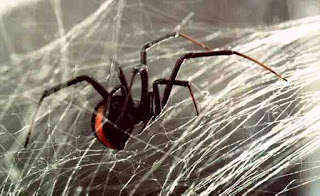One of Australia's best-lmown spiders is the Redback Spider Latrodectus hasseltii, a close relative of America's Black Widow Spider. It is easily identified by the wonderfully striking orange/red slash on its glossy black (sometimes brown) body. The Redback Spider was immortalised in Slim Newton’s 1972 hit song Redback on the Toilet Seat:
There was a Redbnck on the toilet seat
When I was there last night,
I didn't see him in the dark but boy
I felt his bite.
It Probably wasn't a male spider that bit the man in the toilet. Only the female that bites. A male redback is only about a tenth of the female's size. He has fangs but they usually can't penetrate human skin.
Redbacks spin their webs in dry sheltered areas under rocks or logs. They also frequent human places - under eaves, floorboards, garden sheds, in junk piles, gardens and the outdoor dunny! Their webs are spun from spider silk, which is amazing stuff. It comes from glands in the spider’s abdomen. Different glands create different silks for varying purposes. Silk can be used for building a web delivering sperm, holding eggs in a sac, lining burrows and catching prey in sticky nets or single threads. You can recognize a redback”s web because it is tangled and rnessy, not a beautiful work of art like the orb weaver’s.
Hundreds of redback bites are reported each year. A Redback Spider bite can be very painful and a victim may also sweat, become weak, feel sick and vomit. The best thing to do is put an icepack on the bitten area and get the person to hospital for treatment. Someone should try to collect the spider to be sure of its type.
Thankfully, today there is antivenom that can be injected into the victim to treat the bite. There have been no deaths from redback spider bites since the antivenom has been available.To make spider antivenom, first you need to get venom from the spider. For redbacks this means dissecting (cutting open) the glands and tissues of the spider. The purified venom is then injected into horses, in small but gradually increasing doses. The horse produces antibodies to fight the venom. These are taken from the horse using a needle so the life-saving antivenom can be made.
Spiders are arthropods. They have an exoskeleton, an outer skeleton. They moult and shed their outer skeleton as they grow, replacing it with a new, larger exoskeleton. Most spiders are nocturnal, being active at night. Silk line can be as thin as 0.004 millimetres. Some spiders create silk to cast lures while others use silk to help build a cover for their home's entrance. and others use silk to travel on the wind. Net casting spiders make a small web, a net, which they stretch out to catch their prey. Jumping spiders stand and jump on their prey.
◆ Australiana by Ty Buchanan ◆
●
. . . . . . . . . . . . . . . . . . . . . . . . . . . . . . . . . .
SPIDER BITE
#redback #spider #web #silk #bite #antivenom #inject #sweat #sick #unwell
australiana culture redback spider mael femlale bit venom antivenom sting inject horses blood ill sweat cure articles news politics economics society anthropology historiography history sociology people nations country asia europe africa u.s. south america central Mediterranean eastern western interesting funny technology free news
SPIDER BITE
#redback #spider #web #silk #bite #antivenom #inject #sweat #sick #unwell
australiana culture redback spider mael femlale bit venom antivenom sting inject horses blood ill sweat cure articles news politics economics society anthropology historiography history sociology people nations country asia europe africa u.s. south america central Mediterranean eastern western interesting funny technology free news




